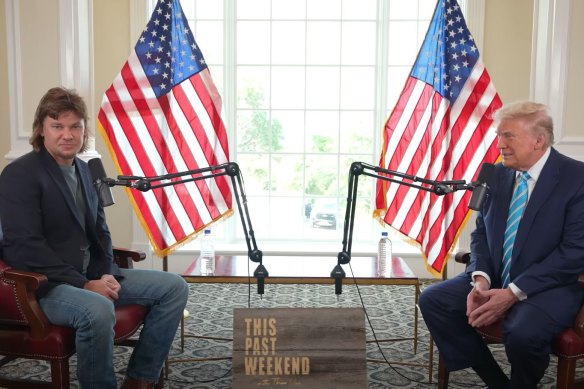
Even an interview with radio shock jock Howard Stern, which confused some given Stern’s long-standing reputation for lewd and crude interviews, makes sense in the context of his listenership, which is predominantly middle-class Americans – a voter base Harris has made the centrepiece of her campaign. This also tracks with Walz’s appearance on SmartLess, a podcast hosted by actors Jason Bateman, Will Arnett and Sean Hayes.
The Democrats’ media strategy suggests three things. First, that Harris and Walz are engaging with podcasts to speak to as many traditional Democratic constituents as possible to reassure them the party is safe. Second, to broaden their appeal and wrest away some of the so-called “bro vote” that Trump has been so successful at courting in recent election cycles. And finally, that they are keenly aware 2024 could be the year that small pockets of undecided voters across key battleground states determine the election.

Donald Trump appeared with Theo Von on the This Past Weekend podcast, and recently told Fox News his 18-year-old son advises him which influencers to do interviews with.Credit: Youtube/This Past Weekend
This final point is perhaps why Republican vice presidential nominee Vance agreed to an almost hour-long podcast interview with The New York Times earlier this month. While Trump has been capitalising on the non-traditional media ecosystem for months by tapping into the so-called “manosphere” of alt-right online spaces with podcasters and YouTubers such as comedian Theo Von, influencer Logan Paul, streamer Adin Ross (who bizarrely gifted Trump a Rolex mid-interview) and the Nelk Boys, Vance’s choice was clearly aimed at reaching a very different group.
While Trump’s choices overwhelmingly reach a younger male audience, a cohort among which he already enjoys large polling margins, young men are low-propensity voters who historically lag when it comes to turning out on election day compared with their female counterparts.
By contrast, the 20 million monthly listeners Vance reached are about as far from alt-right as you can get, with the majority of The New York Times’ audience identifying as left-leaning or politically centrist.
Loading
Unlike Harris, Trump’s podcast appearances seem to speak to voters who are already a fan of his, but are more likely to be politically disengaged. But similarly to her, Trump has been willing to discuss his personal life, talking to Von about his late brother’s battles with alcoholism – an uncharacteristically vulnerable moment from the former president in an interview that has amassed over 14 million views.
As for his strategy, Trump recently told Fox News he’s being guided not by his dozens of staffers, but by his 18-year-old son, Barron. “He tells me about all the ‘hot’ guys, people I’ve never heard of. [He says] ‘Dad, that guy is hot.’”
In contrast to Harris, all signs indicate that Trump is leaning into his 2020 election strategy: doubling down on appealing to his existing base.
But Democrats are seemingly willing to go there too, with reports Harris may appear on The Joe Rogan Experience podcast (where the audience skews young, male and distrustful of traditional media sources).
Perhaps one of the biggest drawcards to this burgeoning format for candidates, though, is that the hosts rarely give them the kind of grilling they usually receive from traditional media. This is unsurprising given most aren’t trained journalists, but it does run the risk of leaving voters with more questions than answers. Or worse, uninspired on election day.
Ava Kalinauskas is a research associate at the United States Studies Centre.
The Opinion newsletter is a weekly wrap of views that will challenge, champion and inform your own. Sign up here.



























